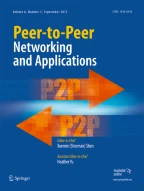Abstract
This paper investigates the distributed model predictive control (DMPC) problem for multi mobile robots. The distributed system model is obtained by the kinematic model of single mobile robot. By including the coupling terms in the cost function, cooperation between subsystems can be incorporated in the distributed control problem. Then, each robot has its own optimal control problem, and neighboring subsystems can exchange information with one another by using wireless communication. The distributed model predictive control problem is formulated by the local cost function and solved by using Nash-optimization algorithm. The convergence condition of the proposed algorithm is presented. Finally, an illustrative example is given to demonstrate the effectiveness of the proposed method.
Similar content being viewed by others
References
Murray RM (2007) Recent research in cooperative-control of multivehicle systems. J Dyn Syst Meas Control 129(5):571–583
Ren W, Atkins E (2007) Distributed multi-vehicle coordinated control via local information exchange. Int J Robust Nonlinear Control 17(10-11):1002–1033
Loria A, Dasdemir J, Jarquin NA (2016) Leader-follower formation and tracking control of mobile robots along straight paths. IEEE Trans Control Syst Technol 24(2):727–732
Sun T, Liu F, Pei H, He Y (2012) Observer-based adaptive leader-following formation control for non-holonomic mobile robots. IET Control Theory and Appl 6(18):2835–2841
Balch T, Arkin RC (1998) Behavior-based formation control for multi-robot teams. IEEE Trans Robot Autom 14(6):926–939
Hong S, Shin S, Ahn D (2001) Formation control based on artificial intelligence for multi-agent coordination. In: Proceedings of the intelligent symposium on industrial electronics, Busan, Korea, pp 429–434
Ren W, Beard RW (2004) A decentralized scheme for spacecraft formation flying via the virtual structure approach. J Guid Control Dyn 27(1):73–82
Antonelli G, Chiaverini S (2006) Kinematic control of platoons of autonomous vehicles. IEEE Trans Robot 22(6):1285–1292
Yoo SJ, Park BS (2013) Formation tracking control for a class of multiple mobile robots in the presence of unknown skidding and slipping. IET Control Theory Appl 7(5):635–645
Rezaee H, Abdollahi F (2014) A decentralized cooperative control scheme with obstacle avoidance for a team of mobile robots. IEEE Trans Ind Electron 61(1):347–354
Shin J, Kim HJ (2009) Nonlinear model predictive formation flight. IEEE Trans Syst Man Cybern Syst Hum 39(5):1116–1125
Yang T, Liu Z, Chen H, Pei R (2008) Formation control and obstacle avoidance for multiple mobile robots. Acta Automat Sin 34(5):588–592
Dunbar WB, Murray RM (2002) Model predictive control of coordinated multi-vehicle formations. In: Proceedings of IEEE Conference on Decision and Control. Las Vegas, pp 4631–4636
Kanjanawanishkul K, Zell A (2009) Path following for an omnidirectional mobile robot based on model predictive control. In: Proceedings of the IEEE International Conference on Robotics and Automation, Kobe, Japan, pp 3341–3346
Liu S, Liu J (2014) Distributed Lyapunov-based model predictive control with neighbor-to-neighbor communication. AIChE J 60(12):4124–4133
Dunbar WB (2005) Distributed receding horizon control of dynamically coupled nonlinear systems. IEEE Trans Autom Control 52(7):1249–1263
Scattolini R (2009) Architectures for distributed and hierarchical model predictive control-A review. J Process Control 19(5):723–731
Christofides PD, Scattolini R, Pena D, Liu J (2013) Distributed model predictive control: A tutorial review and future research directions. Comput Chem Eng 51(14):21–41
Negenborn RR, Maestre JM (2014) Distributed model predictive control: An overview and roadmap of future research opportunities. IEEE Control Syst 34(4):87–97
Farina M, Scattolini R (2012) Distributed predictive control: A non-cooperative algorithm with neighbor-to- neighbor communication for linear systems. Automatica 48(6):1088–1096
Li SY, Zhang Y, Zhu QM (2005) Nash-optimization enhanced distributed model predictive control applied to the Shell benchmark problem. Inf Sci 170(2):329–349
Zhang Y, Li SY (2007) Networked model predictive control based on neighborhood optimization for serially connected large-scale processes. J Process Control 17(1):37–51
Al-Gherwi W, Budman H, Elkamel A (2011) A robust distributed model predictive control algorithm. J Process Control 21(8):1127–1137
Zhang LW, Wang JC, Wang BH (2015) Distributed MPC of polytopic uncertain systems: handling quantised communication and packet dropouts. Int J Syst Sci 46(13):2393–2406
Zhang LW, Wang JC, Li C (2013) Distributed model predictive control for polytopic uncertain systems subject to actuator saturation. J Process Control 23(8):1075–1089
Zhang LW, Wang JC, Ge Y, Wang BH (2014) Robust distributed model predictive control for uncertain networked control systems. IET Control Theory Appl 8(17):1843–1851
Stewart BT, Venkat AN, Rawlings JB, Wright SJ, Pannocchi G (2010) Cooperative distributed model predictive control. Syst Control Lett 59(8):460–469
Dunbar WB, Murray RM (2006) Distributed receding horizon control for multi-vehicle formation stabilization. Automatica 42(4):549–558
Kanjanawanishkul K, Zell A (2008) Distributed model predictive control for coordinated path following control of omnidirectional mobile robots. In: Proceedings of the IEEE International Conference on Systems, Man and Cybernetics, Singapore, pp 3120–3125
Necoara I, Clipici DN, Olaru S (2013) Distributed model predictive control of leader-follower systems using an interior point method with efficient computations. In: Proceedings of the 2013 American Control Conference, Washington, DC, pp 1696–1672
Hashimoto K, Adachi S, Dimarogonas DV (2015) Distributed aperiodic model predictive control for multi-agent systems. IET Control Theory Appl 9(1):10–20
Gu D, Hu H (2006) Receding horizon tracking control of wheeled mobile robots. IEEE Trans Control Syst Technol 14(4):743–749
Meng W, Yang Q, Sun Y (2016) Guaranteed performance control of DFIG variable-speed wind turbines. IEEE Trans Control Syst Technol. doi:10.1109/TCST.2016.2524531
Zhang H, Cheng P, Shi L, Chen J (2016) Optimal DoS attack scheduling in wireless networked control system. IEEE Trans on Control Syst Technol 24(3):843–852
Acknowledgments
The work was supported partly by the National Natural Science Foundation of China under Grants No. 61304040 and 61403344, the Zhejiang Provincial Natural Science Foundation of China under Grant No. LZ15F030003, and the Hong Kong Scholars Program (XJ2015040).
Author information
Authors and Affiliations
Corresponding author
Rights and permissions
About this article
Cite this article
Liu, A., Zhang, R., Zhang, Wa. et al. Nash-optimization distributed model predictive control for multi mobile robots formation. Peer-to-Peer Netw. Appl. 10, 688–696 (2017). https://doi.org/10.1007/s12083-016-0479-7
Received:
Accepted:
Published:
Issue Date:
DOI: https://doi.org/10.1007/s12083-016-0479-7
